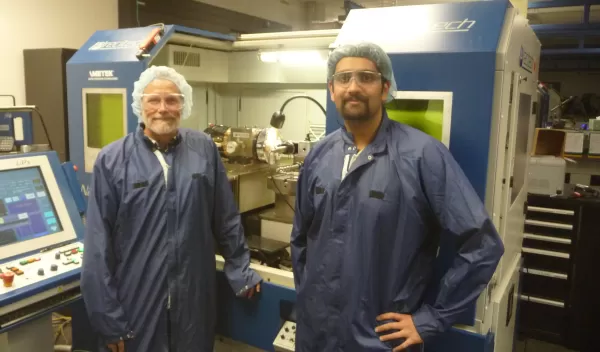
New tool, savings for manufacturing hard materials
"Machining," in particular the process of cutting hard, brittle materials during manufacturing, can be difficult, often because the cutting tool, typically made of single crystal diamond, the hardest material known, can wear out. Also, machining can take a long time.
Scientists at Western Michigan University thought they could improve upon it by designing new technology that could speed up the system and make the cutting tool last longer. The idea not only was to create a superior end product, but also to save time and money doing so.
"The biggest issue with diamond cutting is that diamonds are expensive," says John Patten, chair of the manufacturing engineering department at the university and director of its Manufacturing Research Center. "If you can find a way to soften the material it is cutting, that is, expose the diamond to a softer material, it doesn't wear as much, so you don't have to replace it as often, having to shut down the machine when you do."
Patten and his research colleague, Deepak Ravindra, with support from the National Science Foundation (NSF), developed the new Micro-LAM (Laser Assisted Machining) process, which adds a focused laser to the high pressure diamond cutter. Heat from the laser softens the material, cutting it more quickly, thus conserving the life of the diamond. The new process also results in a smoother surface on the product, making it easier to shape, and eliminating the need for subsequent post-processing smoothing.
"In theory, you cannot make a diamond any harder than it already is, so our only option was to preferentially soften the workpiece material during the manufacturing/machining process," Ravindra says. Furthermore, "the technology actually works better at higher speeds," he adds.
The hybrid tool contributes to less breakage and fracturing, and makes the material stronger, enhancing its integrity. This means savings for manufacturers and, presumably, also for consumers. Potentially, the device could have a major impact in the aerospace and defense industries, including in the manufacture of high powered electronics, computer chips, and lenses, windows and mirrors for optical and laser systems.
The system "addresses all of the main challenges associated with manufacturing hard and brittle materials such as ceramics and semiconductors," Ravindra says. It is "a retrofitable solution provided to manufacturing companies that allows them to machine parts faster, better and cheaper. We truly believe that we will be able to provide our customers with the technology to profitably manufacture superior parts without compromising on material quality."
NSF supported the scientists with a $50,000 Innovation Corps (I-Corps) grant, awarded in 2012, which supports a set of activities and programs that prepare scientists and engineers to extend their focus beyond the laboratory into the commercial world. The goal of the I-Corps program is to help researchers translate their discoveries into commercial technologies with near-term benefits for the economy and society. It is a public-private partnership program that teaches grantees to identify valuable product opportunities that can emerge from academic research, and offers entrepreneurship training to student and post-doctoral participants.
In 2011, Patten and Ravindra formed a company, Micro -LAM Technologies, headquartered in Kalamazoo and Battle Creek, to manufacture and sell their device. Patten is its chief scientific officer, while Ravindra is the company's chief technical officer.
The commercialization of their innovation came after several decades of research. Before experimenting with new technology, they realized they had to better understand the old. The scientists wanted to know why, even with its drawbacks, the process did not result in material that cracked or fractured when it was cut. "We had learned over the years how to machine these brittle materials without breaking them, but we didn't know why we were able to do this," Patten says.
They discovered that the material undergoes a brief phase transformation, from semi-conducting to metallic, during the cutting process, making it more "machinable." When the cutting is complete, the material returns to its original form.
"Basically, you start with this hard, brittle material, and due to the influence of the diamond tool, it transforms into a softer, ductile material, that is, a metal," Patten says. "Then it reverts back. It only stays in that high pressure phase when the diamond is in contact with the material. It reverts back naturally, but it's not always controllable. Later, with the laser and heating, however, we found we could control it."
Once they understood what was happening to the material, they began experimenting to find ways to further soften the material during cutting. They tried various chemicals and electricity, and, while "most worked, they were difficult to envision commercializing," Patten says.
Their "aha" moment came once they realized that "diamond is transparent to most laser wave lengths," meaning they could focus a laser through the diamond and change the properties of the material being cut without affecting the diamond.
"We shine the laser light through the diamond and focus it on the cutting edge," Patten says. "We have developed a hybrid process. We can do it directly through the diamond tool, which makes the hybrid configuration realizable. We actually can make it work."
The laser thus becomes an attachment to the existing equipment, "like adding a stereo to your car," he adds. "Before you had a stereo, you would sing in your car. So, this, too, is an enhancement."


